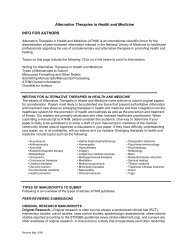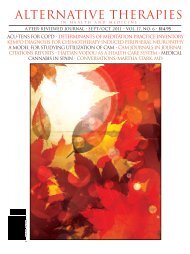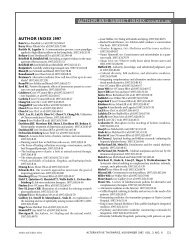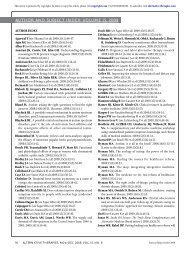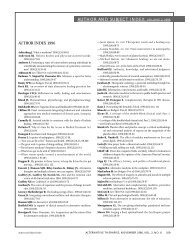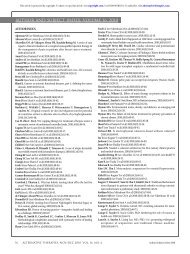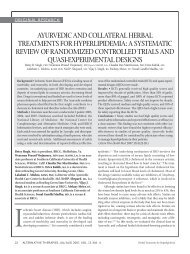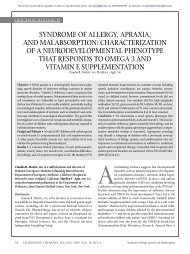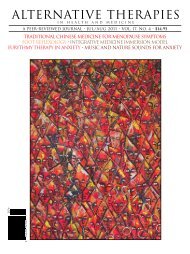Alternative Therapies In Health And Medicine
Alternative Therapies In Health And Medicine
Alternative Therapies In Health And Medicine
Create successful ePaper yourself
Turn your PDF publications into a flip-book with our unique Google optimized e-Paper software.
TABLE 5 The Percentage Changes in Heart Rate Variability<br />
Measures After Foot Reflexology*<br />
%X30 %X60<br />
Control group (n = 17)<br />
Mean RRI; % –0.6 (–4.0 to 4.8)‡ –4.2 (–9.1 to 0.9)<br />
Heart rate; % 0.6 (–4.6 to 4.0)‡ 4.3 (–0.8 to 10.0)‡<br />
SD RR<br />
; % 0.0 (–10.4 to 6.5) –13.3 (–17.6 to –1.2)‡<br />
CV RR<br />
; % –0.5 (–8.7 to 8.1) –4.6 (–12.5 to 1.1)<br />
TP; % –5.7 (–21.9 to 18.4) –28.0 (–36.0 to –8.4)‡<br />
VLFP; % -12.2 (–38.6 to 3.6) –56.0 (–69.8 to –33.9)‡<br />
LFP; % 0.0 (–15.7 to 19.1) –23.2 (–39.6 to 13.3)‡<br />
HFP; % 3.6 (–9.1 to 30.2) –6.9 (–30.0 to 13.0)<br />
nVLFP; % –9.3 (–42.5 to 1.1) –37.3 (–49.6 to –26.5)<br />
nLFP; % 1.0 (–9.2 to 24.7) 14.1 (–2.9 to 23.5)<br />
nHFP; % 9.9 (–0.0 to 41.3) 18.0 (7.8 to 52.0)<br />
LFP/HFP; % –14.3 (–28.5 to 16.6) –5.7 (–23.2 to 7.9)<br />
CAD group (n = 20)<br />
Mean RRI; % 6.6 (3.1 to 11.1)† 10.9 (3.5 to 17.7)†<br />
Heart rate; % –6.2 (–10.0 to –3.1)† –9.9 (–15.0 to –3.4)†<br />
SD RR<br />
; % 4.3 (–8.7 to 23.7) 3.8 (–6.6 to 11.0)†<br />
CV RR<br />
; % 0.0 (–12.8 to 12.4) –6.0 (–10.4 to –2.0)<br />
TP; % 11.3 (–25.1 to 58.9) 14.5 (–13.3 to 38.5)†<br />
VLFP; % –0.3 (–39.9 to 21.6) –14.5 (–40.6 to 10.3)†<br />
LFP; % 7.6 (–22.3 to 72.8) 13.8 (–6.7 to 40.7)†<br />
HFP; % 10.0 (–13.2 to 53.3) 32.4 (6.0 to 59.2)†<br />
nVLFP; % –16.4 (–28.2 to –2.9) –18.4 (–40.6 to –4.5)<br />
nLFP; % 0.5 (–6.7 to 7.1) 2.0 (–5.1 to 11.7)†<br />
nHFP; % 8.9 (0.0 to 25.9) 15.1 (1.3 to 33.1)<br />
LFP/HFP; % –11.2 (–23.3 to 2.1) –9.1 (–31.5 to 3.7)<br />
*Values presented are medians (25-75 percentile).<br />
†P < .05 between normal controls and patients with CAD.<br />
‡P < .05 vs before FR.<br />
§P < .05 vs 30 min after FR.<br />
Abbreviations: CAD, coronary artery disease; RRI, RR intervals; SD RR , standard<br />
deviation of RR; CV RR , coefficient of variation of RR; TP, total power;<br />
VLFP, very low-frequency power; LFP, low-frequency power; HFP, high-frequency<br />
power; nVLFP, normalized very low-frequency power; nLFP, normalized<br />
low-frequency power; nHFP, normalized high-frequency power; LFP/HFP,<br />
low-/high-frequency power ratio.<br />
related to vagal modulation, last longer in patients with CAD than in<br />
the controls. The mechanism responsible for this differential effect<br />
was not clear at present because it was not investigated in this study.<br />
We speculate that the FR-related autonomic nervous effect of increasing<br />
vagal and decreasing sympathovagal balance may be more evident<br />
in those patients who have depressed vagal modulation and<br />
enhanced sympathetic modulation, such as patients with CAD.<br />
Further studies are needed to disclose the underlying mechanism.<br />
Other considerations include that the manipulation of FR on a<br />
participant did not allow him or her to rest uninterruptedly. Thus, a<br />
participant not receiving FR is not a good control to contrast the<br />
effect of FR on that person. If a control is going to be used to contrast<br />
the effect of FR, manipulating some area other than the foot that has<br />
no reflex points on it for the same period of time may be a better<br />
choice than a participant not receiving FR. According to the traditional<br />
Oriental medicine, no area over the whole body can be found<br />
TABLE 6 Effect of Beta-blockers on Heart Rate Variability in the<br />
Control and Coronary Artery Disease (CAD) Groups*<br />
Control Group (n = 17) CAD Group (n = 20)<br />
Without beta-blockers (n = 12)<br />
TP (ms2) 861.6 (696.0-9876.9) 1415.0 (467.0-2036.0)<br />
VLFP (ms2) 312.0 (176.2-406.9) 218.0 (165.3-733.0)<br />
LFP (ms2) 174.5 (158.5-255.1) 382.0 (127.7-641.2)<br />
HFP (ms2) 373.3 (228.2-493.5) 460.5 (194.4-927.8)<br />
nVLFP (nu) 36.0 (24.3-41.9) 31.2 (26.2-37.7)<br />
nLFP (nu) 23.8 (20.2-29.2) 28.2 (26.4-31.3)<br />
nHFP (nu) 42.9 (35.4-48.1) 37.7 (33.2-48.6)<br />
LFP/HFP 0.53 (0.48-0.81) 0.82 (0.52-0.90)<br />
With beta-blockers (n = 25)<br />
TP (ms2) 1083.1 (827.2-2104.0) 962.5 (7484.1-1375.0)<br />
VLFP (ms2) 311.9 (197.5-514.1) 288.4 (173.8-444.4)<br />
LFP (ms2) 337.1 (177.9-413.1) 256.8 (219.4-437.9)<br />
HFP (ms2) 354.1 (318.7-625.3) 480.2 (318.4-546.6)<br />
nVLFP (nu) 33.0 (30.3-41.3) 30.5 (24.1-32.7)<br />
nLFP (nu) 28.3 (21.5-30.1) 28.6 (25.2-32.4)<br />
nHFP (nu) 38.5 (32.6-44.0) 43.2 (35.5-46.2)<br />
LFP/HFP 0.74 (0.59-0.81) 0.65 (0.53-0.82)<br />
*Values presented are medians (25-75 percentile).<br />
Abbreviations: TP, total power; VLFP, very low-frequency power; LFP, lowfrequency<br />
power; HFP, high-frequency power; nVLFP, normalized very lowfrequency<br />
power; nLFP, normalized low-frequency power; nHFP, normalized<br />
high-frequency power; LFP/HFP, low-/high-frequency power ratio.<br />
that can be stimulated by pressure and massage without causing a<br />
physiological response in the body. Therefore, the participant not<br />
receiving FR in either group was not designed as a control to contrast<br />
the effect of FR in this study.<br />
To know the differences in the effects of FR on patients who are<br />
on different medications and the effects of those medications on FR,<br />
we chose to compare the effect of beta-blockers on the HRV measures<br />
in both control and CAD groups. We found that there were no<br />
significant differences in all HRV measures between participants<br />
using or not using beta-blockers in either control or CAD group and<br />
between the control and CAD groups whether they were using betablockers<br />
or not (Table 6). Thus, there are no differences in the effects<br />
of FR on CAD patients whether or not they are on beta-blocker medication,<br />
and the beta-blockers do not significantly influence the effect<br />
of FR on the autonomic nervous modulation of the participants.<br />
<strong>In</strong> conclusion, a higher vagal modulation, lower sympathetic<br />
modulation, and lower blood pressures can be observed following 60<br />
minutes of FR in both angiographically patent controls and CAD<br />
patients. Though the magnitude of change in the autonomic nervous<br />
modulation of the CAD patients was slightly smaller than that of the<br />
controls, FR is a complementary therapeutic method to allopathic<br />
medical care that is simple and safe for almost everyone. FR requires<br />
very little time and expense, no special equipment, and no medication<br />
and can be performed practically anywhere. Since the mortality<br />
risk due to acute myocardial infarction is lower in patients with higher<br />
vagal modulation and is higher in patients with higher sympathetic<br />
modulation, our research suggests that FR is a safe, low-cost adjunct<br />
Foot Reflexology in Coronary Artery Disease<br />
ALTERNATIVE THERAPIES, jul/aug 2011, VOL. 17, NO. 4 13



